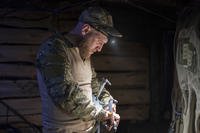Air Force Chief of Staff Gen. Mark Welsh and the man who would succeed him, Vice Chief of Staff Gen. David Goldfein, both said this week that automatic spending caps are what spurred the service's decision to push for the retirement of the plane.
Welsh reiterating that reason to a room full of reporters on Wednesday, while Goldfein offered the same take to the Senate Armed Services Committee during his confirmation hearing on Thursday.
"The A-10 has never been the issue -- ever," Welsh told reporters. "The issue is the Budget Control Act and the limited resources we have to modernize the Air Force," he added, referring to the law that set spending caps known as sequestration. "We don't have the option of keeping everything."
Meanwhile, Goldfein told lawmakers that he could not give "a better of example of what sequester did to the United States Air Force than the A-10 discussion, because it was sequester in fact that brought us the A-10 retirement."
But advocates of the gunship and the close air support mission for which it was designed say the leaders are using the spending issue as a convenient excuse and nothing more.
Pierre Sprey, a defense analyst who assisted in the design of the A-10, didn't mince words when asked for his reaction to the comments. "Pure crap," he told Military.com.
He said the Air Force has disliked the plane -- also known as the Warthog -- "ever since we forced it into the Air Force inventory in 1974."
Journalist and author Robert Coram also pointed out that Air Force leaders were planning to discard the A-10 more than a dozen years ago.
"If there were no sequester the leadership would find another excuse to mask their driving imperative of retiring the A-10," said Coram, author of "Boyd: The Fighter Pilot Who Changed the Art of War," a biography of Air Force fighter pilot and military strategist Col. John Boyd. "Put bluntly, the AF leadership is not telling the truth. But then, they have a history of this."
Coram revealed in a March 2003 New York Times op-ed column that the head of Air Combat Command sought to decommission the A-10 fleet as early as 2004.
This time around, the Air Force was going full speed ahead with plans to mothball the A-10 when it was blocked on two fronts. Capitol Hill lawmakers wanting to keep it alive and the campaign against the Islamic State in Syria and Iraq, where the plane found a new mission. Still, the Air Force plans to eventually retire the plane.
Dan Grazier, a former Marine Corps officer now with the Project on Government Oversight, a public interest watchdog group, said the Air Force "has long wanted to do away with the close air support mission because it places the service into a secondary role to the Army and Marine Corps fighting on the ground."
Grazier said the Air Force has always favored fighter planes and long-range bombers as its air power strategy.
Sprey said he was an early advocate of a close air support platform, and when he championed the concept in the publication Inside the Air Force in 1968 "it made me instantly public enemy No. 1" with the Air Force.
"But it also got me invited to help design the A-10" with Col. Avery Kay, considered the father of the aircraft, he said.
The Air Force went along with the aircraft's development only because it feared the Army, in need of and determined to have a close air support plane, would develop something on its own, Sprey said.
"The Air Force is built on independent bombing [strategies] … and close air support is selling out to the Army," he said. "It has nothing to do with money, either. The A-10 is cheap -- it's a tiny amount of money. You could cancel 10 F-35s and pay for the entire cost of the A-10 program."
Sprey drew a parallel to how the Air Force treated the C-27J Spartan, a small, twin-engine cargo plane sought by the Army but which the Air Force elbowed its way into by maneuvering to make it a joint aircraft.
After taking delivery of a few dozen aircraft starting in 2008 it began retiring them just five years later. At one point 21 new planes were flown from the manufacturing plant directly to the boneyard at Davis-Monthan Air Force Base in Tucson, Arizona. Of these, the Air Force subsequently transferred 14 to the U.S. Coast Guard and another five to Army Special Operations Command.
The A-10, nicknamed the Warthog for its bulky, muscular frame and fierce combat capabilities -- it has a seven-barrel 30mm cannon capable of destroying any infantry or armor target -- and is able to come in low and slow to hit those targets.
Air Force officials argue they are not abandoning the close air support mission but that other aircraft now provide the same capability. Advanced sensors and laser-guided weaponry have enabled F-16s to successfully conduct close air support in Afghanistan, service officials said in 2013.
"You don't need to fly slow with a lot of titanium armor with a 30-mm gun just to be able to do close air support," the Air Force's military deputy for acquisitions said at the time. "We've got B-52s and B-1s doing close air support. The weapons have changed the game."
Goldfein told the Senate panel considering his nomination to lead the Air Force that the sequester last year created an "$8 billion math problem" that the service had to solve by cuts.
If it is hit again next year the Air Force will be facing a "$10 billion math problem," he said.









